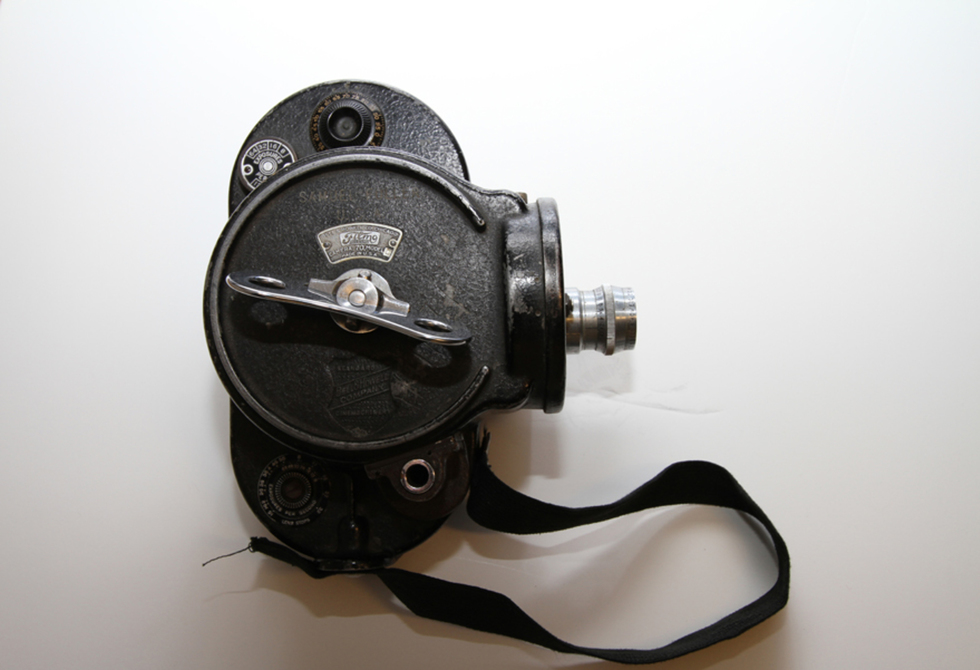
BY BETSY ALDREDGE |
Filming the Camps: From Hollywood to Nuremberg
Now through October 14, the Museum of Jewish Heritage's new exhibit tracks legendary directors John Ford, George Stevens and Samuel Fuller through their documentation of the liberation of WWII concentration camps.

Samuel Fuller’s Bell & Howell Camera / © Courtesy of the Academy of Motion Picture Arts and Sciences, Beverly Hills, California, Coll. Christa Fuller
John Ford, George Stevens, and Samuel Fuller entertained audiences with American cinema classics like The Grapes of Wrath, Shane, and The Big Red One. But their most important contribution to history was their work in the U.S. Armed Forces and Secret Services.
The Museum of Jewish Heritage’s new exhibition, Filming the Camps: John Ford, Samuel Fuller, George Stevens: From Hollywood to Nuremberg, presents rare footage of the liberation of Dachau with detailed directors’ notes and the documentary produced as evidence for the Nuremberg trials.
One fascinating thing about the exhibit is that it enables us to view the footage in its historical context and read the accompanying narratives written by the cameramen and writers, practically in real-time, as soon as they finished shooting for the day. The exhibit also shows the impact of having witnessed that history on the later work of these filmmakers. For instance, George Stevens, who was well-known for his work with Fred Astaire and Ginger Rogers, went on to direct The Diary of Anne Frank in 1957. Stevens said, “I couldn’t continue to make films like before.”
The exhibit is also a who’s who of Hollywood at the time. Stevens’ unit (the SPECOU) involved 45 cameramen, writers, sound operators, and assistant directors who called themselves “The Hollywood Irregulars.” The crew included writers Ivan Moffat, screenwriter for Giant, Tender is the Night; Pulitzer Prize-winning author William Saroyan; and Irwin Shaw, screenwriter for THE Talk of the Town and Desire Under the Elms. Cameraman William C. Mellor would go on to win the Oscar for cinematography for The Diary of Anne Frank and A Place in the Sun.
 © Courtesy of the Margaret Herrick Library, Academy of Motion Picture Arts and Sciences, Beverly Hills, California
© Courtesy of the Margaret Herrick Library, Academy of Motion Picture Arts and Sciences, Beverly Hills, California
During the war, director John Ford headed the Field Photographic Branch. In his civilian life, Ford directed the 1940 Academy Award-winning film The Grapes of Wrath. In 1945, Ford incorporated images of Dachau taken by Stevens’ crew into a documentary first shown in the United States, and later used as evidence of Nazi crimes before the International Military Tribunal at Nuremberg. Ford also oversaw the filming of the Nuremberg Trials themselves. Among Ford’s crew were Gregg Toland, the director of photography of The Grapes of Wrath and Citizen Kane, actor, editor, and future director Robert Parrish, and Ray Kellogg, Ford’s right-hand man.
Samuel Fuller joined the 1st Infantry Division of the U.S. Army in 1942 and at the instruction of his captain, filmed the liberation of the Falkenau camp with a camera that Fuller’s mother sent him. It was his first filming experience. He subsequently had a successful film career, directing more than 25 films between 1949 and 1989, including The Big Red One, which reflected some of his wartime experiences.
The exhibit is on display through October 14 at the Museum of Jewish Heritage—A Living Memorial to the Holocaust.
A series of public programs will be presented across the city in conjunction with the exhibition opening including master classes, film screenings, curator talks, and the U.S. premiere of curator Christian Delage’s new film.
Visit www.mjhnyc.org/ftc for more information.
Betsy Aldredge is the public relations manager at the Museum of Jewish Heritage, and had worked in arts journalism for several years prior to coming to the museum.
The exhibition, curated by historian and film director Christian Delage, was designed, created, and circulated by the Mémorial de la Shoah (Paris, France) and made possible through the generous support of the SNCF. The New York presentation of Filming the Camps is made possible through the generous support of the Pickman Exhibition Fund.

